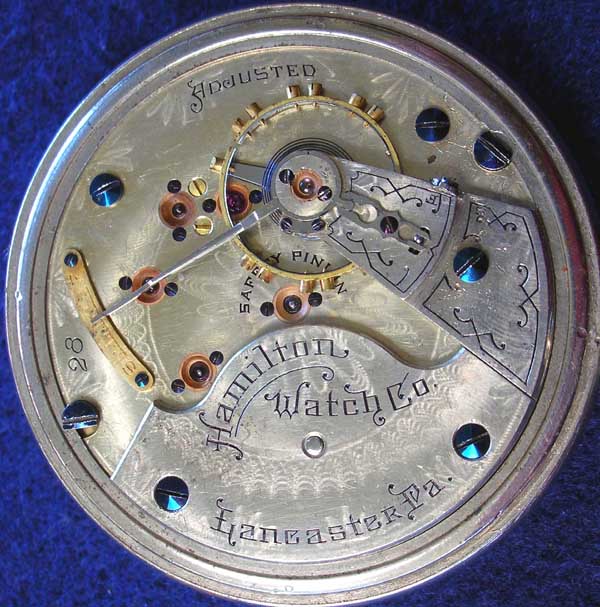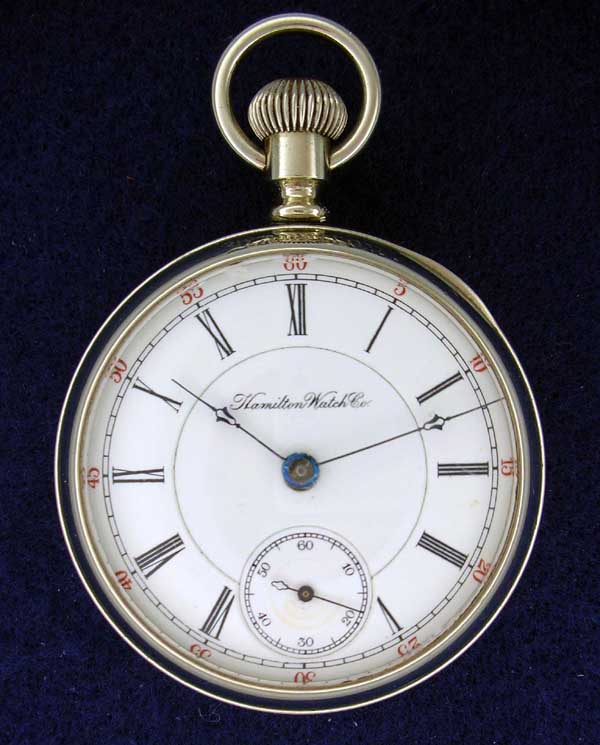
| WWT Shows | CLICK TO: Join and Support Internet Horology Club 185™ | IHC185™ Forums |

|
• Check Out Our... • • TWO Book Offer! • |
Welcome Aboard IHC185™  Internet Horology Club 185
Internet Horology Club 185  IHC185™ Discussion Site Main Page
IHC185™ Discussion Site Main Page  Horological Discussions, Questions and Answers
Horological Discussions, Questions and Answers  Pocket Watch Discussions
Pocket Watch Discussions  The First Hamilton Watch?
The First Hamilton Watch?
 Internet Horology Club 185
Internet Horology Club 185  IHC185™ Discussion Site Main Page
IHC185™ Discussion Site Main Page  Horological Discussions, Questions and Answers
Horological Discussions, Questions and Answers  Pocket Watch Discussions
Pocket Watch Discussions  The First Hamilton Watch?
The First Hamilton Watch?Go  | New Topic  | Find-Or-Search  | Notify  | Tools  | Reply to Post  |  |
| IHC Member 500 Wristwatch Expert |
I’m sure that most people here know that my primary interest is in Hamilton wristwatches, especially the Electrics. But I also love pocket watches and have several, including the unique Lucite 992 (which I posted a year or two ago) and a 7-Jewel Hamilton made in February, 1894, as well as a few others, not exclusively from Hamilton. But as a Hamilton historian I love everything about the company so I’m extremely excited about my latest acquisition. Was this the first Hamilton ever made? Maybe, maybe not (probably not, given the odds...). There’s no way to know the order in which Hamilton assembled the first batch of watches. But this Grade 932 pocket watch, serial number 28, is documented as one of 37 watches completed on the very first day of production at the Hamilton factory: November 25, 1893. The Hamilton Watch Company filed for incorporation on November 18, 1892 and its charter was granted on December 14th. There was already a factory building in place, acquired from the defunct Lancaster Watch Company. Nonetheless it took a year to equip the factory and design a movement. Most of the machinery and employees were brought in from Lancaster Watch and the Aurora Watch Company, both of which had been bought out by Hamilton co-founders Charles Rood and Henry Cain. Hamilton’s first movements were based on an earlier design that Cain had conceived at Aurora. As I’m sure everyone on this board knows, Hamilton used the block system of serial numbering from the very beginning, assigning a range of numbers to a specific movement type. These blocks were tiny in the beginning, nothing like the huge ranges later on. Numbers 1-20 were reserved for grade 936, 21-30 for grade 932, 31-60 for grade 936, 61-400 for grade 932 etc. Even within blocks no attempt was made to assemble watches in consecutive order. Plates were made, engraved with serial numbers, then pulled somewhat randomly from the bins when watches were assembled. This accounts for some seemingly incongruous manufacture dates, with serial numbers very much out of sequence. Hamilton’s original ledgers still survive, archived in the library. These records show that on that first day of production Hamilton finished 37 watches, serial numbers 2, 3, 4, 7, 8, 11, 12, 13, 14, 17, 20, 22, 24, 25, 27, 28, 29, 31, 32, 34, 36, 37, 38, 40, 41, 43, 44, 46, 47, 48, 49, 50, 55, 56, 57, 58, and 59. (Movement number 1 was reserved for its historic significance and was not completed until April 21, 1896. It was kept in the company archive. Movements 1 and 2 are both in the NAWCC museum today.) Serial number 28 was also among the first Hamilton watches ever sold, on December 9th, 1893, to H.M. Shreiner of Lancaster, PA. Hamilton sold 15 watches on that first day of business – numbers 3, 4, 8, 9, 20, 22, 24, 25, 27, 28, 30, 48, 50, 52, and 73. When it comes to Hamilton watches, they just don’t come any earlier. There is one unusual feature worth noting: there is no regulator spring. It is not missing, it was never there – there are no holes for a steady pin or mounting screw. Note also that the shape of the ‘dog bone’ link between the adjusting screw and the regulator is slightly different from the usual 932 or 936. What seems odd is that serial #2, made on the same day and now displayed at the NAWCC, does have a regulator spring. Was it perhaps changed in a later repair? I’d love to see any examples that may survive of the other watches made on that same date to see if in fact the lack of a spring was simply a very early characteristic. (The one pictured here has the serial number stamped on the bottom of the balance cock and scribed on the balance wheel, so they are clearly original to the watch.)  | ||
|
| IHC Member 500 Wristwatch Expert |
Here's the dial.  | |||
|
| IHC Member 500 Wristwatch Expert |
The original entry in the Hamilton ledger.  | |||
|
Thanks for the history lesson Rene' and for the photo of #28. That is a real honey and if anyone deserves it, you do! Ron | ||||
|
| IHC Member 660 |
The early regulator in this watch was explanied in the Hamilton article that apperaed in the October 2002 Bulletin. Hamilton No. 3, shown on the cover of that Bulletin, has the same arrangement. The regulator tension spring is hidden on the under-side of the balance cock. It had too little force for reliable operation, so was changed. Apparently about 1500 movements were machined for the first regulator spring, but most were changed to the fianl design. Mike | |||
|
| IHC Member 500 Wristwatch Expert |
Thanks for that information, Mike. I don't have that issue handy but your explanation certainly makes sense. There is some 'slop' in this regulator, it is possible to move it slightly in either direction so it's definitely not reliable. According to the Hamilton logs, number 3 was bought back in September 1926 and sold to Henry Ford in January 1927. I assume that the picture in the Bulletin was supplied by the Ford Museum. | |||
|
| IHC Member 376 Watchmaker |
Rene what a great and important Hamilton watch thanks for sharing it with us. | |||
|
| IHC President Life Member |
Beautiful movement, great story! Thanks to René for sharing it with us. | |||
|
Thank you, Rene and Mike. Very important historical material here. Cheers! Joel | ||||
|
| IHC Member 660 |
Rene, interesting information regarding performance of the regulator. The "slop" would be called backlash in gearing systems, and is exactly what the spring is supposed to eliminate. So, equivalent mechanisms in gearing are called anti-backlash devices. The problem occurs when making small regulator adjustments that reverse direction (the last adjustment was Fast, and now we go Slow). The first small adjustment in the reverse direction does nothing, or does too little. In "Its About Time" Chamberlain complains of regulators that produce unreliable or unpredictable results through flexibility or backlash. And, certainly a wonderful watch, by the way. MIke | |||
|
Rene' What an honor it is, to be able to see this! Thank you, Thank you! Sheila | ||||
|
| Powered by Social Strata |
| Your request is being processed... |
|
©2002-2025 Internet Horology Club 185™ - Lindell V. Riddle President - All Rights Reserved Worldwide

